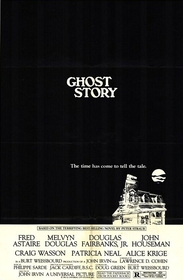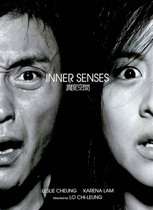Our editor-in-chief Nate Yapp is proud to have contributed to the new book Hidden Horror: A Celebration of 101 Underrated and Overlooked Fright Flicks, edited by Aaron Christensen. Another contributors include Anthony Timpone, B.J. Colangelo, Dave Alexander, Classic-Horror.com's own Robert C. Ring and John W. Bowen. Pick up a copy today from Amazon.com!
Ghost Story (1981)
Director John Irvin's 1981 film, Ghost Story, based on a novel by horror fiction icon Peter Straub, is a charming but eerie sojourn into a niche of horror that covers most of the stylistic bases of the genre. It does so in a deceptively simple way that almost demands multiple viewings; each time you watch you're likely to appreciate the film and its atmosphere even more, like nestling further into the ephemeral folding spirals of a numinous chambered nautilus.
On your first viewing of Ghost Story, you're likely to be a bit confused for at least the first 30 to 40 minutes. Some might see this as a flaw initially, but it isn't. The confusion stems not from Irvin and scriptwriter Lawrence D. Cohen doing an insufficient job, as you might first suspect. Rather, they've decided to take a marvelous risk and tell their story differently. Ghost Story has many nonsequential elements and the point of view is a cloaked one--you have to play detective a bit and try to piece together what seems to be a surreal series of images. At first you think you're doing this in conjunction with the character Don Wanderly (Craig Wasson), but then you realize that he knows far more than Irvin initially let you in on. The viewer is set in a kind of middle space where both Wanderly and the four elderly members of the "Chowder Society" try to keep secrets from each other, but the secrets have to be uncovered if there's to be any hope of them remaining alive.
After you've made it to the end of Ghost Story the first time and many of the puzzle pieces have clicked together, your reaction is likely to be a desire to immediately start over from the beginning of the film. This time, what seemed like Dario Argento-like image poetry now makes perfect sense and you'll notice that the smallest of details--the quietest bits of dream dialogue, the most fleeting of images, the metaphors of the Chowder Society's regular ghost story get togethers--all lock into place. If you were to watch the film in its entirety again and start over from the beginning a third time, you'd likely catch even more details. I don't know how many times this might work until you tire of the film for one day; I didn't have time to get that far.
Aside from the peculiar beauty of the structure, a number of other unusual elements will strike you, all with similarly distinctive, cohering flavors. One is John Cardiff's cinematography. Irvin and Cardiff stress a strange palette of strong browns, dark oranges and bleached grays. These are nicely offset by gorgeously photographed snow, which lends a cold, elegant austerity to the proceedings-appropriate for the subject matter. The range of the cinematography is represented nicely in the first ten minutes, from the firelit, intense faces of the Chowder Society in full throttle to a drive-by view of snow-covered trees which seem to pop out of your screen as a deep three-dimensional backdrop.
Another extraordinary element is Philippe Sarde's score, which is perfectly grand, cultivated and twisted at the same time. Again the first ten to fifteen minutes show the range of the score nicely, from driving title music, to eerily melancholy music when we see the Chowder Society having nightmares, to haunting, slow "carnival music" while Dr. Jaffrey watches David's funeral from his car.
The third thing that's likely to stand out, especially from our late 20th/early 21st Century perspective is that the core cast consists of senior citizens. Bruce Campbell, of Evil Dead fame, summed up the trend nicely in a recent essay that appeared in Wicked magazine (Fall 2000). "Recently," says Campbell, "I watched a rerun of the 60's TV show 'The Fugitive' and was shocked to see how 'mature' the actors were. With very few exceptions, each was pushing 30 or beyond . . . I couldn't help but laugh because it seems ALL of Hollywood is young today. Hell, if David Janssen (star of 'The Fugitive') were on Dawson's Creek, he'd be cast as someone's dad." Bruce is right. Ghost Story seems odd because we're so used to films staring kids who aren't old enough to possess graduate degrees. The excellence of Fred Astaire, Melvyn Douglas, Douglas Fairbanks, Jr. and John Houseman (the youngest, Fairbanks, is about 71 here), not to mention Patricia Neal and Jacqueline Brooks, in this film shows what a mistake it is to emphasize youth in films at the expense of more chronologically varied casts.
Ghost Story plays its horror cards in all suits, from classical atmospheric chills (and as a note to Irvin's love for detail, watch how the wind doesn't begin to blow in the graveyard until Houseman says, "And the wind began to blow") to Dick Smith's excellent zombie make-up. It's not gory, really, but some scenes, such as a body falling from a high-rise, shattering through a glass roof, and landing with a thud next to a pool, are more brutal than usual--Irvin graphically captures the tragedy and weight of the fall in a way that splattered body parts simply couldn't do. The film's real strength, though, lies in its ability to create ghostly thrills via deep characters who have a reason to be scared. And that, combined with all the other unique, superb elements, make this a must see for any genre fans or any serious fan of film.









Peter Straub is one of my
Peter Straub is one of my favorite authors and I did not even know this film was out there!
You just don't see horror
You just don't see horror movies like this anymore. Hollywood has changed over the decades and it just dosen't produce films that pique my interest.
Alice Krige is beautiful, powerful, and frightning. She plays a far more sophisticated figure in this movie than she did as the "Borg Queen" in Star Trek. Her role in Chariots of Fire is also very dynamic.
Seasoned names like Fred Astaire, Douglas Fairbanks Jr., John Housman, and Patricia Neal also add class to the movie.
Director John Irvin did something very rare in Hollywood; he took a novel( courtesy Peter Straub) and made it even better with the movie version.
When I saw this movie in 1983 as a 14-year-old, it scared the pants off me! The latter "slash" films such as Nightmare on Elm Street and Friday the 13th don't even scratch the surface of this movie.
Hopefully, Mr. Irvin will make another film that's just as potent as Ghost Story.